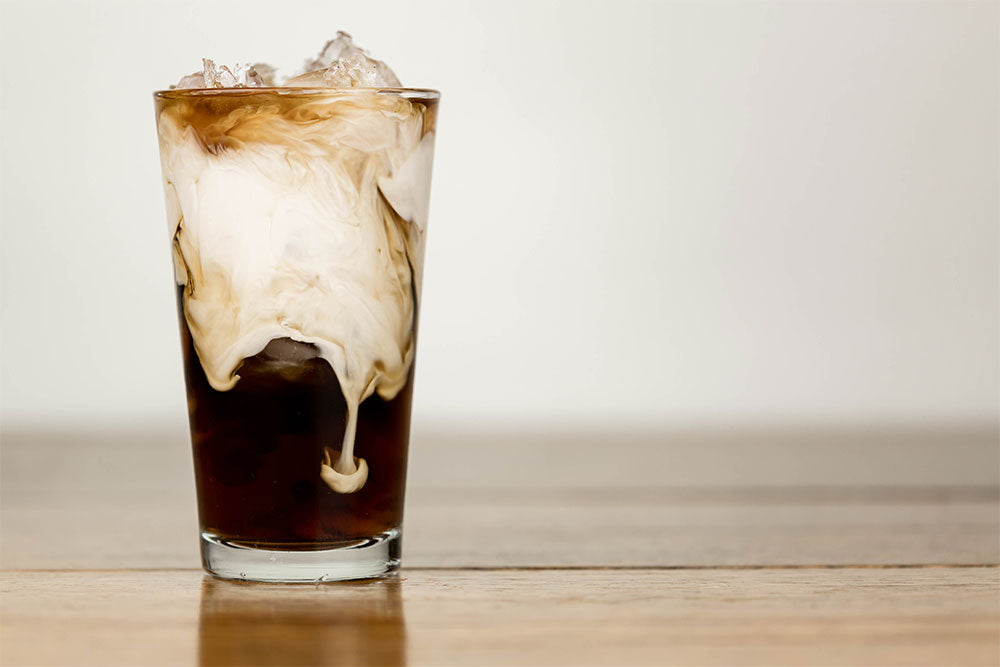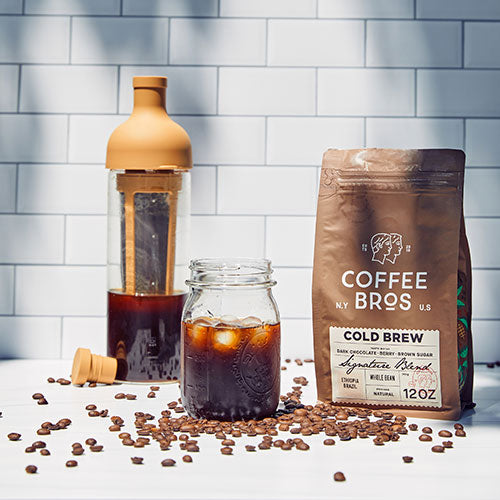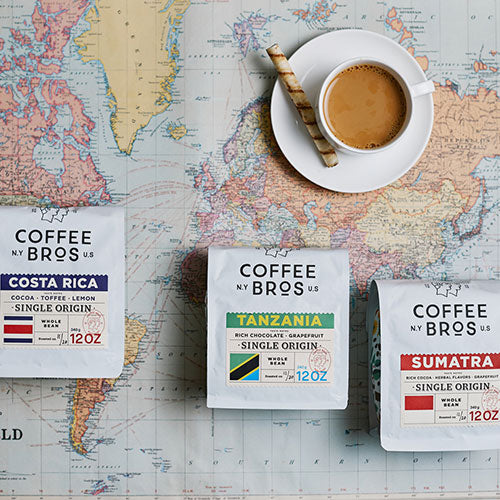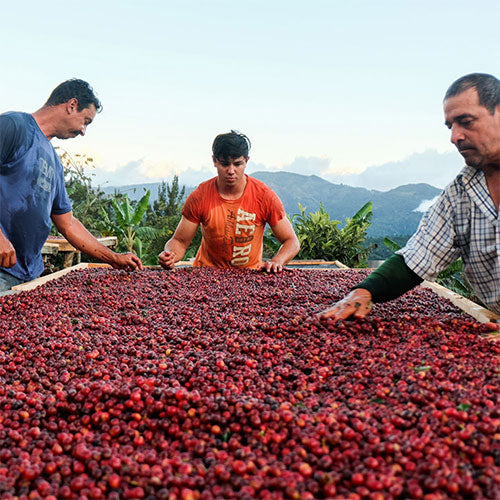The difference between Cold Brew, Iced Coffee, Japanese Iced Coffee, Snapchilled Coffee, and Cold Drip Coffee
Introduction
The days of ordering a plain iced coffee and being certain of what you'll receive are no more. Today, coffee enthusiasts, roasters, and cafes are offering a variety of cold coffee creations, ranging from delightful brews from cold drip coffee towers to canned Snapchilled coffee.
This article aims to explain the primary distinctions between each brewing style, including flavor, brewing method, and which one may be the most suitable for your tastes. So, pour yourself a chilled coffee and prepare to discover all there is to know about cold coffee!
All About Cold Coffee:
-
The differences between iced and cold brewing methods
- How temperature plays a role
- How time plays a role
- Main taste differences between hot and cold brewing coffees
-
Cold Brew Coffee
- Cold Brew Coffee Definition
- Best Equipment for Cold Brew
- Best Coffee for Cold Brew
-
Iced Coffee
- Iced Coffee Definition
- Best Equipment for Iced Coffee
- Best Coffee for Iced Coffee
-
Japanese Iced Coffee
- Japanese Iced Coffee Definition
- Best Equipment for Japanese Iced Coffee
- Best Coffee for Japanese Iced Coffee
- Snapchilled Coffee
-
Cold Drip Coffee Tower
- Cold Drip Tower Coffee Definition
- Best Cold Drip Coffee Tower
- Best Coffee for the Cold Drip Coffee Tower
- All Cold Coffee Recipes
The differences between iced and cold brewing methods
The variation in taste among different methods of brewing cold or iced coffee can be attributed to a few key factors. Just like with any other brewing technique, factors such as the roast level of the coffee (light, medium, dark) and the processing method (natural, washed, honeyed) have a significant impact on the final taste. However, when disregarding roast level and processing method, the following are the primary factors that affect the differences between various types of cold brewing:
- Time: time refers to the first contact of water with coffee until the brew is complete.
- Brewing temperature: the average temperature at which the cold brew or iced coffee variation is brewed.
- Brew ratio: the coffee-to-water ratio difference between each brewing method
Temperature plays a big role in the differences in these brew methods mostly when it comes to comparing cold brew and the cold drip tower to iced coffee, Japanese iced coffee, and Snapchilled coffee.
How temperature plays a role in extraction:
The extraction of substances from coffee grounds is affected by water temperature, with the recommended range for hot coffee being brewed between 195-205°F. Using water that's too hot can lead to excessive bitterness due to acid breakdown and too quick of extraction, while water that's too cold may not extract enough non-acidic compounds, resulting in sourness (except when cold brewing, more on that later). Think of an espresso shot that brewed far too long and was overly bitter or a shot that pulled super-fast and was sour and thin.
Cold brewing on the other hand due to the length of extraction and cooler brewing temperatures, results in coffee with up to 66% less acidity and bitterness than hot brewing. Cold water inhibits the extraction of acids that cause bitterness and slows down the oxidation of acids that provide a sharp taste, leading to a less tangy and acidic flavor. Cold brews take longer but have a milder flavor than hot brews of the same beans because lower water temperature leads to slower extraction, with some compounds not being extracted at all.
| Brewing Method | Time | Brew Temperature | Brew Ratio |
| Cold Brew | 16 - 24 hours | Room temperature or cold water | 1:6 (to make concentrate) |
| Iced Coffee | ~3:00 minutes | 195 - 205°F | 1:18 - 1:13 |
| Japanese Iced Coffee | ~3:00 minutes | 195 - 205°F | 1:18 - 1:13 |
| Snapchilled Coffee | ~3:00 minutes | 195 - 205°F | 1:18 - 1:13 |
| Cold Drip Coffee Tower | 12 - 16 hours | Room temperature or cold water | 1:9 (to make concentrate) |
How time plays a role in extraction:
The timing differences for each brewing method are due to the brewing temperatures. Coffee that is brewed at the standard 195 - 205°F will brew using similar times for your standard pour-over or drip coffee recipes. While coffee brewed at room temperature or cold water need much longer brew times to assist with extraction even though some compounds (only extracted using hot water) will not be extracted at all.
Taste differences between cold coffee brewing methods:
If we disregard the coffee roast level, processing type, and varietal from the equation the differences in taste between these brewing methods again come down to time and temperature.
Brewing coffee using the standard temperature range of 195-205°F results in the extraction of various compounds, including fruit acids, caffeine, lipids, melanoidins, carbohydrates, and plant fiber. While some of these compounds may still extract at lower temperatures, cold brewing inhibits much of the acidity during the brewing process.
A fantastic cup of hot brewed coffee is characterized by a well-rounded flavor profile, a pleasant aroma, subtle sweetness, crisp acidity, and a touch of bitterness that harmoniously blends together. On the other hand, an excellent cup of cold brew coffee has a smooth taste, rich sweetness, minimal acidity, and virtually no bitterness. Cold-brewed coffee is great for those looking for a drink with low acidity. Pair this brewing type with low-pH water (Fiji, Evian) and you’ll have a stomach-friendly brew!
Although cold brew coffee doesn't have the same pronounced aroma as hot brewed coffee, there's a scientific explanation for it. The aromatic oils in coffee are volatile and evaporate quickly when exposed to high temperatures, which is why hot brewed coffee has a more distinct aroma, but you can solve that using a simple trick during the brewing process (which we will get into more below).
Taste notes of Cold Brewed Coffee
Taste notes of Hot Brewed Coffee
The Coffee Taster's Flavor Wheel, which has become a well-known tool in the coffee industry, was originally released in 1995 and has served as the industry benchmark for more than 20 years. In partnership with World Coffee Research (WCR), this important resource was revised in 2016. The World Coffee Research Sensory Lexicon, which forms the basis of this update, was the result of the combined efforts of numerous sensory experts, scientists, coffee purchasers, and roasting companies who collaborated through WCR and SCA. This extensive research on coffee flavor is the most comprehensive and cooperative of its kind and has introduced a fresh vocabulary for professionals in the industry.
Coffee roasters, buyers, baristas, and even consumers of coffee use this wheel to better understand the coffee they are drinking.
The idea is to start in the center of the wheel with its broad descriptors of taste and then move outward to refine and get more specific on the flavor notes you may be tasting when evaluating coffee.
Since cold-brewed coffee only leverages room temperature or cold water, the types of notes you can achieve in this brewing style are limited to the left side of the wheel. Much of the notes that one would think of within the citrus family are often not present when cold brewing coffee.
We have achieved bright notes when brewing light-roasted coffee with a slow drip coffee tower but your standard immersion cold coffee brewing often lacks the acidic punch you can expect when brewing coffee with hot water.
Again, we have a few tips you can take if you are looking for more brightness in your cold brews that we detail below.
Cold Brew Coffee
What is Cold Brew Coffee:
Cold brew coffee is a distinctive brewing technique that uses time and temperature to influence the taste and flavor of the resulting beverage. Typically, this method involves immersion brewing, which involves steeping coffee grounds in room temperature or cold water for 16 to 24 hours. Since cold brewing doesn't utilize hot water, the resulting brew has a lower acidity level, making it an excellent option for those who are sensitive to high acidity levels in traditional hot brewed coffee.
Cold brew coffee is known for its rich and bold flavor, which has a heavy mouthfeel and features notes of nuttiness, cocoa, roastiness, and some sweetness. One of the unique characteristics of cold brew coffee is that it can be brewed as a concentrate (using a 1:6 ratio) and later diluted with water or milk when serving to reduce the intensity of the flavor. However, some people prefer to consume the concentrate on its own.
Best Equipment for Cold Brew Coffee
When it comes to coffee brewing equipment you can go as simple and inexpensive as a mason jar and cheesecloth or slightly more expensive equipment like using a Toddy or Filtron system.
We recommend using a Toddy but appreciate the mason jar and cheesecloth approach as a great way to test different brews (coffee types, and timing) without having to commit to making a large batch of cold brew.
Best Coffee for Cold Brew
We find the best types of coffees for the cold brewing method to be medium or dark-roasted coffees and find light roasts to not work extremely well with this brewing method. We have had some lighter roasted medium coffees like our Kenya single-origin that made a wonderful cold brew but anything too bright or acidic can get a bit overwhelming with this brewing style.
We find medium to darker roasted naturally processed coffees like our Cold Brew coffee blend to work extremely well for this brewing style. We specifically chose coffee that naturally leans toward the cocoa, nutty, and red fruit sweetness which is further highlighted by this brewing style.
We always recommend coffees that have underlying chocolate characteristics as a good place to start when doing cold immersion brewing. We shy away from coffees roasted too dark and find any dark roasts that spot oil may be too intense in flavor when brewing cold brew. If you are a super dark roast coffee lover, consider brewing your cold brew toward the short end of the range at around 16 hours to get the best results.
Iced Coffee
What is Iced Coffee:
The method of brewing iced coffee involves preparing hot coffee and subsequently cooling it down then pouring it over ice. This approach offers great flexibility, as any hot brewing technique can be utilized, followed by cooling the coffee. While the V60 pour-over method is the most prevalent method for making iced coffee, you can also effortlessly prepare pressed iced coffee using an AeroPress or a French press.
To avoid excessively diluting your iced coffee, it's recommended to allow it to cool or refrigerate it before adding ice and consuming it. If you're using a typical pour-over recipe, it's essential to ensure that the addition of ice does not affect the coffee-to-water ratio if your coffee is too hot.
Best Equipment for Iced Coffee
We prefer using a pour-over like the V60 and using bright and fruit-forward single-origin coffees for this brewing method.
You can also explore making “pressed” iced coffees using an AeroPress or French Press. Again, stick with your standard recipes here, let the coffee cool down either in the fridge or on the tabletop before adding ice. The key here is to keep your coffee-to-water ratios intact and not let the melting of the ice create a diluted drink.
Best Coffee for Iced Coffee
For iced coffee brewing your choices are endless. Hopefully, you already have a favorite coffee that you brew hot and maybe even a preferred brewing method, we suggest starting there! We love changing our iced coffees based on the season, there are some wonderful floral and fruit-forward coffees in the late spring and early summer from Ethiopia and Kenya which can make fantastic, iced coffees. Heading into the fall we love brewing coffees from Nicaragua and Costa Rica and in the winter a nice round and bold Brazil or Peruvian coffee can make a fine choice. Again, since you are brewing hot, your choices are endless here and can change each season or you can stick with your favorite year-round blend.
Japanese Iced Coffee
What is Japanese Iced Coffee:
Japanese iced coffee is a way of flash-chilling your coffee by brewing it over ice. The V60 is the preferred brewing method, using standard coffee-to-water ratios, and adjusting for the ice (and its melting) in the ratio. While Japanese iced coffee allows for a faster cold drink preparation than traditional iced coffee, improper execution can result in a diluted drink. To prevent this, ensure your recipe is precise, consider the ice in your calculations, and grind your coffee a bit finer than usual to slow the water flow through your V60 (as you'll be using less water during brewing).
Best Equipment for Iced Coffee
Similar to making a standard iced coffee, we prefer using a pour-over like the V60 and using bright and fruit-forward single-origin coffees for this brewing method.
You can also explore making “pressed” Japanese iced coffees using an AeroPress and brewing over ice. Again, stick with your standard recipes, as the key here is to keep your coffee-to-water ratios intact and not let the melting of the ice create a diluted drink.
Best Coffee for Japanese Iced Coffee
When making Japanese iced coffee, it's best to use a light and bright coffee as the quick cooling process enhances the coffee's aroma. With a standard brew ratio, but accounting for the ice, Japanese iced coffee brews faster and usually has a lighter body compared to traditional iced coffee or cold brew. Our preference is for a single-origin coffee that is lightly to medium roasted, and we've had excellent outcomes with coffee from Kenya, Ethiopia, and Costa Rica.
Snapchilled Coffee
What is Snapchilled Coffee:
Snapchilled coffee is a technique that involves extracting hot coffee and rapidly cooling it to cold temperatures in a matter of seconds. The chilled coffee is then hermetically sealed in a can, preserving the delicate flavors and aromas from the hot brew. Elemental Beverage company holds a patent for the Snapchill technology used in all their partner's coffee cans, and we had the opportunity to try it a few years ago.
Here’s how it works:
- The coffee is brewed hot. Only hot water can extract all the flavors, acids, sugars, and oils you know and love as “brewed coffee”, so that’s where the process begins.
- It’s “snapchilled” in a matter of seconds. Basically, a mad scientist machine cools the coffee instantly using thermodynamics and other science-y processes without ice. In fact, it makes the coffee colder than ice—something that’s impossible without powerful machines. This preserves even the most delicate flavors and aromas.
- The coffee is sealed tightly in a can. Just like wine, all the flavors are perfectly captured, safely waiting for some lucky coffee lover to pop them up.
Pop it open and enjoy. The coffee is made at the perfect strength, so you can enjoy as-is without dilution. And since there’s no ice, it doesn’t get watered down eithe
Best Equipment for Snapchilled Coffee
This is a tough brewing method to replicate at home but we decided to include it in our write up as it is certainly an enjoyable one to try. We recommend heading over to Snapchill.com and searching for one of their many partners who can with them!
Cold Drip Coffee Tower
What is Cold Drip Coffee Tower:
The cold drip coffee tower is a distinctive method of cold coffee brewing that combines various techniques we previously mentioned. Unlike immersion cold brewing, cold drip coffee towers take 12-16 hours to produce coffee, using a slow drip process with no coffee immersion. The water drip rate is adjusted to control the brewing time, with faster drips leading to a quicker brew. The cold drip tower is unique as water slowly permeates the coffee bed over the entire brewing period, contrasting hot-to-cold methods that involve a standard pour-over recipe or immersion brew, where coffee and water are in contact throughout the brewing process.
The cold drip coffee tower offers a distinct flavor profile compared to other brewing methods, and is versatile across roast levels, though lighter roasts work exceptionally well, creating a super sweet and bright coffee. The recommended coffee-to-water ratio is 1:8 - 1:9 to create a concentrate, which can then be diluted with water or milk to your preference.
Best Equipment for Cold Drip Coffee Tower
There is only one reliable and well-made tower on the market and that is from the Taiwanese-based glass company, Yama. Taiwan's Yama Glass factory is renowned for producing exquisite, hand-blown glassware that is both tempered and heat-resistant. The unique characteristics of this glass make it ideal for use in cold brew coffee towers, siphon coffee makers, and stunning teapots.
Though pricey, this well-built cold drip tower is an eye-catcher and is great for any home coffee setup or café.
Our pick: 6-8 Cup Cold Drip Maker Straight Black Wood Frame (32oz)
Best Coffee for Cold Drip Coffee Tower
When using the Cold Drip Coffee tower, we suggest using medium-roasted coffee, though light-roasted coffees can produce unique and delicious brews for those who enjoy bright and sweet coffee. It's best to avoid brewing anything too dark with this method.
Cold Brew Coffee Recipe
What equipment is needed:
For cold brew coffee, we suggest using either a mason jar with cheesecloth or purchasing a Toddy for those that was to brew in larger batch sizes.
Recipe Summary:
Equipment: Toddy Cold Brew system
Coffee-to-water Ratio: 1:6 coffee-to-water ratio to create coffee concentrate
Water temperature: We prefer room temperature water, cold water is not necessary nor is putting the Toddy system in the fridge when brewing.
Amount of coffee: 340 grams (one 12 ounce bag)
Amount of water: 72 ounces
Grind size: Coarse
Total brew time: 16 - 24 hours
Step-by-step Cold brew coffee recipe:
- Place the 340 grams of coffee into the Toddy Cold Brew system
- Add half of the water over the coffee and then stir with a spoon
- Add the remaining water to the mix and ensure all of the cofffee is saturated
- Let the mixture steep for 16-24 hours, depending on your preference for strength. We prefer 16 hours using a medium-roasted coffee.
- Strain the liquid by opening the cork at the bottom of the Toddy system.
- To finish, mix 1:1 or 1:2 parts of the concentrate with water to make your final beverage.
Iced Coffee Recipe
What equipment is needed:
For iced coffee, any filtered or drip coffee brewing method can work if you keep the standard coffee-to-water ratio intact. We prefer using the pour-over method with a V60 but if you are looking to make a larger batch of iced coffee, consider using a coffee machine like the Breville Precision Brewer and leveraging their Golden Cup Ratio setting.
Recipe Summary:
Equipment: Hario V60
Coffee-to-water Ratio: 1:14 (darker roasts) - 1:17 (lighter roasts)
Water temperature: 85 - 100 degrees Celsius (revisit the above section on brew temperatures)
Amount of coffee: 20 grams of coffee
Amount of water: 340 grams of water
Grind size: Medium coarse
Total brew time: 3:00 - 4:00 minutes
Step-by-step pour-over recipe: (Lance Hendrick)
We like to follow the Lance Hendrick pour-over recipe as it is quite versatile across coffee roast levels. Here is how Lance suggests brewing a pour-over.
- Bloom size: 3x the weight of your coffee with water. If you are using 20 grams of coffee, use 60 grams of water for your bloom.
- Bloom length: 1 – 2 minutes – user bloom time closer to 2 minutes if the coffee is fresh off roast.
- Remaining pour: After the bloom is complete, pour the remaining water at 6-8 grams a second until you hit the final weight. If the coffee is draining too slowly, it is okay to swirl the bed of coffee to help improve the flow rate.
After you finished making your pour over, either let the coffee cool on the countertop or toss it in the fridge for faster cooling. Do not add ice right off of the brew as the ice will melt and dilute your coffee. The idea here is to let the coffee cool before adding in your ice.
Japanese Iced Coffee Recipe
What equipment is needed:
For Japanese iced coffee, we prefer using the pour-over method with a V60 as this brewing method is a bit tougher to do with larger batch brewing systems.
Recipe summary:
Equipment: Hario V60
Coffee-to-water Ratio: 1:14 (darker roasts) - 1:17 (lighter roasts)
Water temperature: 85 - 100 degrees Celsius (revisit the above section on brew temperatures)
Amount of coffee: 20 grams of coffee
Amount of water: 280 grams of water
Amount of ice: 60 - 70 grams of ice
Grind size: Medium (slighly finer than your standard pour over recipe)
Total brew time: 3:00 - 4:00 minutes
Step-by-step Japanese Iced Coffee Recipe:
- Weigh 20% of your total brew weight (340 grams) in ice (60 - 70 grams) and place the ice in your brewing vessel.
- Grind your coffee slightly finer than you would with your standard pour-over. Since you are using 20% less water in the recipe, the goal is to slightly slow down your total brew time to still reach roughly 3:00 minutes.
- Bloom size: 3x the weight of your coffee with water. If you are using 20 grams of coffee, use 60 grams of water for your bloom.
- Bloom length: 1 – 2 minutes – user bloom time closer to 2 minutes if the coffee is fresh off roast.
- Remaining pour: After the bloom is complete, pour the remaining water at 6-8 grams a second until you hit the final weight. If the coffee is draining too slowly, it is okay to swirl the bed of coffee to help improve the flow rate.
After you finished making your pour over, your coffee should be cool enough to add additional ice since you brewed ontop of 70 grams of ice.
Cold Coffee Drip Tower Recipe
What equipment is needed:
For Japanese iced coffee, we prefer using the pour-over method with a V60 as this brewing method is a bit tougher to do with larger batch brewing systems.
Recipe summary:
Equipment: Yama Glass Coffee Tower
Coffee-to-water Ratio: 1:9 coffee-to-water ratio to create coffee concentrate
Water temperature: cool or cold water can be used. Some brew with ice water but this extends the brew time and also drastically fluctuates the temperature throughout the brew making it quite inconsistent. We recommend sticking with cool or room temperature water.
Amount of coffee: 100 grams of coffee
Amount of water: 900 grams of water
Grind size: Medium coarse
Total brew time: 12 - 16 hours
Step-by-step Cold Coffee Drip Tower recipe:
- Place the ceramic filter at the bottom of the glass center
- Weigh and grind 100 grams of coffee at a medium coarse setting and place it in the glass center
- Pre-wet the paper filter and place it on top of the coffee grounds. The paper filter helps with the even distribution of water
- Add 900 grams of cool water to the top glass container
- Turn the water drip valve until you are getting an average of 30 - 35 drops per minute. At this rate, you will finish your brew within 12 hours. You will need to adjust the valve every few hours as the flow rate slows over time.
- Once the brew is complete, add and additional 5 - 7 parts of water or leave as is and enjoy a very robust coffee concentrate.




